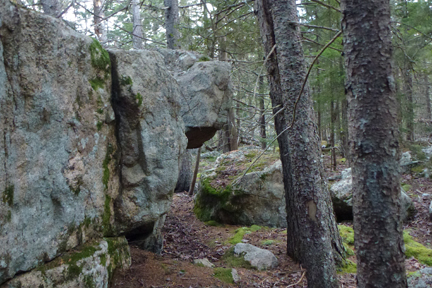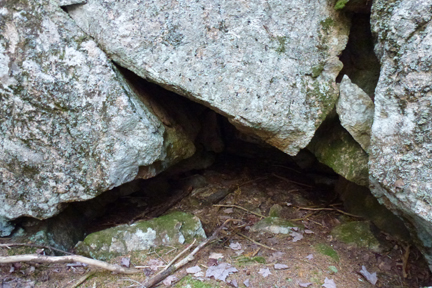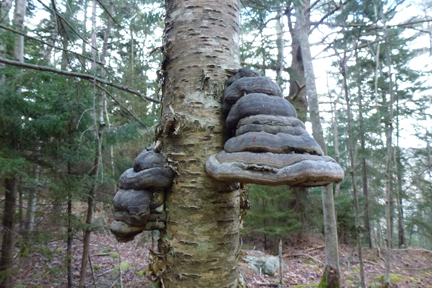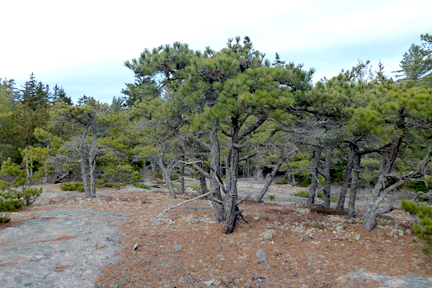
It is the time of year when days are short. During the week it is barely light when I head to work, and usually dark when I head home. Weekends are the chance to get some sun and soak in those warm vitamin D filled rays. There are plenty of reasons to be outside—hunting down and cutting the Christmas tree, stringing lights, gathering mussels, bringing in wood for the stove—but these only give a few hours, if that, of outdoor time.
There are only sixteen short hours of daylight each weekend, weekends that include commitments like family gatherings, indoor construction projects, laundry and other household tasks. This weekend we celebrated Christmas with cousins, aunts, siblings, and in-laws. Otter Creek, where we live, and many at the gathering grew up, was of course a topic. The Tarn, a small pond where people used to skate, fish and iceboat, is filling in. Coyotes, unheard of thirty years ago, boldly sit by the road munching on their kill. Someone mentioned playing in caves were they were little, and wondered if anyone had been there lately. Caves? As we drove home I begged for more information.
I knew these would not be caves as most people think of caves—deep, extensive, a place to get lost in or explore. But I have lived in Otter Creek close to half my life, and had not heard about these caves. Sunday, I had already begged, we would get outside for some sun. Now we had a purpose, we were going to find caves.
The modest mountains of Acadia National Park have several caves. Day Mountain is a two-mile walk from our house, and the caves there are deep enough to reach a point where no daylight enters. I would crawl in, and squeeze into the little corner where light did not reach, and crouch with my eyes wide open. I played with touching my nose, and moving my hands towards each other, index fingers pointing, and seeing if I could get them to meet. This is a place I love to share with visitors.
One friend, huddled next to me, said turn on the flashlight. We gazed horrified at the dozens of large black spiders on the roof of our cranny, inches above our hair.
I was ready for some new caves. “How big?” I asked. My husband said he couldn’t really remember, but that they were big enough to fit inside. He said when he was young his grandfather told him he used to go up there with the girls. His grandfather was not specific about what they did, but the implication was they were big enough to get in out of the rain.
Sunday, chores were done or shrugged off. There was sun, glorious sun. It was twenty-one degrees. We got directions from neighbor Clyde, who has spent all his life in the Creek and knows every inch of it.
We headed up the steep hill behind the Otter Creek Hall (formerly the Congregational Church). I had walked back there a few times, and we tap trees in that area for maple syrup. We went beyond that. We followed deer trails to an old property road, which marked a boundary of David Bracy’s land. David was one of the village settlers. The day was crisp and fine, and I was so happy to have the sun on my face that the search became secondary, as we knew it would.
After a short climb we reached an open ledge, a rocky stretch with twisted pitch pines and Dorr Mountain in the distance. There is a pitch pine grove behind my house, and these small growths are suggestive of Chinese watercolors. There is little underbrush, and the short stunted pines seem to rise out of the granite ledges. Silver grey deer moss covers the rocks. Frost edged a the opening of chipmunk hole, and we saw three more entrances to this little chipmunk community. A large aspen had extensive beaver teeth marks along the bottom. It was a big tree, and I am not surprised he gave up.
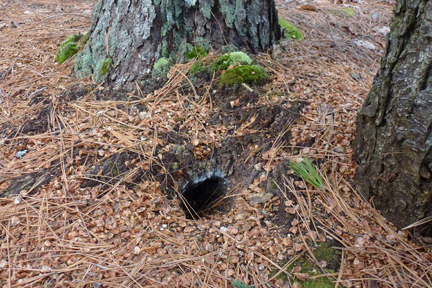
We continued to follow the old road, and there, plunk in the middle of the woods, was a fish shack. “That belonged to Mike Bracy,” my husband said. Around 1970 Acadia National Park employees were instructed to go to Otter Creek and destroy all the villager’s fish shacks. Later, they rebuilt Mike’s shack, and he moved it up into the woods. He was getting old, and no one really understands the logic behind the move, but there it is, a sturdy little building with newspaper insulation. Someone has sprayed a peace symbol on it, and some plastic toys lie abandoned inside the door.
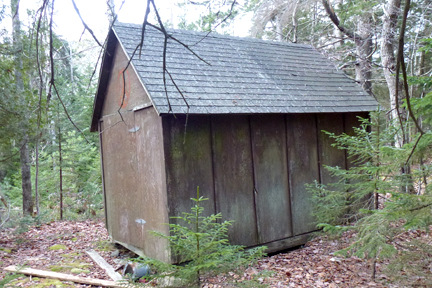
Under a hemlock tree we saw the scrapings a buck had made with his hoof, and I was told they almost always marked their territory under an evergreen. I asked why, but did not get an answer.
After an open trail and sloping woodland floor we came upon a tumble of boulders and ledges. There were overhangs, and some dark crevices, but nothing I would call a cave unless I was ten inches tall. Someone had been up there cutting brush, about two years ago judging by the ages of the cut marks. Several tall spruce were splattered with sap. Something, wasps, parasites, I do not know but welcome a scientist to explain, had wounded the trees and they were producing sap and making spruce gum. Otter Creek spruce gum was once sold in New York markets as chewing gum.
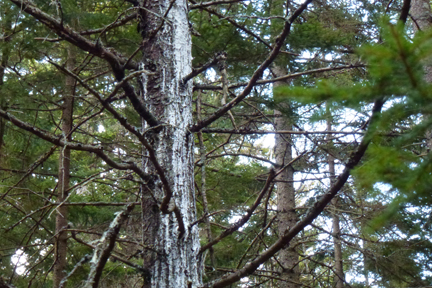
The sun was already heading for the mountain that would soon hide it. We passed another hoof pattern in the earth, and sure enough it was under another hemlock. Could it be buck’s mark elsewhere, but it is only in the clear, needle covered space that we notice it?
I have had some sun, and while I did not get to crawl into a spider infested cave, I have learned a little more about the people who came before me in this village of mine, and explored a few hills and ledges I had never seen before.
